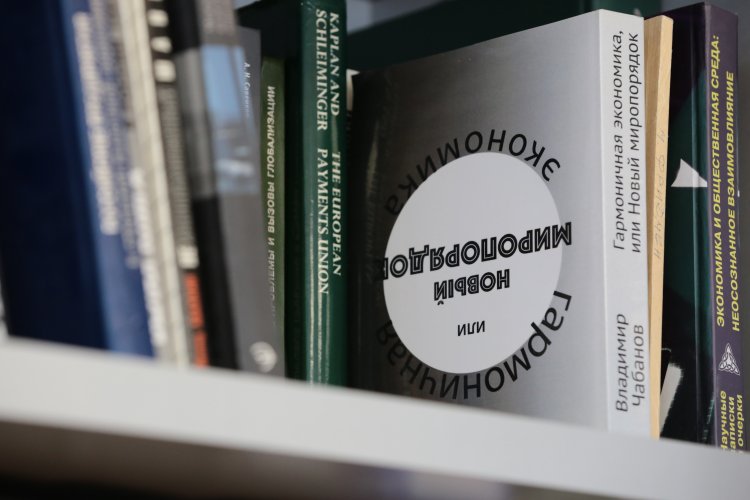From April 1, 2023, the Central Bank of the Russian Federation is launching a pilot project to introduce a digital ruble. The new form of money locked on the country's key emission regulator will become an alternative to cash and noncash settlements.
What is the fundamental difference of the digital ruble from cash and noncash money and cryptocurrencies? Why do they introduce the new form and what will be its effect on the economic situation in Russia? What countries are introducing national digital currencies? Read answers to these questions in our interview with Director of the Institute of Economics of the Russian Academy of Sciences, Corresponding Member of the Russian Academy of Sciences Mikhail Yuryevich Golovnin.
Director of the Institute of Economics of the Russian Academy of Sciences, Corresponding Member of the Russian Academy of Sciences Mikhail Yuryevich Golovnin
Photo: Olga Merzlyakova / «Scientific Russia»
― Our last meeting with you took place two years ago, in the spring of 2021. At that time, our interview was about cryptocurrencies and the NFT market: at that moment, Bitcoin had significantly risen in price, which caused a surge of interest in alternative money. You said that both the Central Bank of Russia and the central banks of other states were preparing to introduce digital national currencies. Now, the preliminary stages are over and Russia starts to openly test its digital ruble. What is digital ruble? What are its fundamental differences from noncash payment?
― Indeed, many countries have gone a long way towards the introduction of national digital currencies that are often referred to as “digital cash.” According to the Central Bank, digital currencies are the third form of money: there is cash, there is noncash, and now there is also digital money. Consequently, this is the digital ruble in Russia.
It is similar to cash, as it helps quite easily make transactions with counterparties. These transactions are made not via accounts but via an electronic wallet being the only one for each economic agent, while there can be many accounts. Unlike noncash money issued by commercial banks, the digital ruble issuer is the Central Bank. The crucial difference between digital and cash money is that the new form is not anonymous: one can trace transactions and deals, which is impossible when it comes to paper money. Anonymity as an important benefit of cash disappears in this case.
― However, the digital ruble is based on the technology of cryptocurrencies that were renowned, among other things, for their anonymity.
― The technological basis of cryptocurrencies and digital money might look the same, but these are two fundamentally different approaches. Verification is decentralized when it comes to cryptocurrencies, all network participants are responsible for it. However, the verification of the system of digital national currencies is centralized and its main participant is the Central Bank that sees all transactions.
― Why do they introduce the digital ruble? Do they expect it to influence the Russian economy?
― The activity around private digital currencies grew significantly several years ago. This is relevant not only to cryptocurrencies, but also to stablecoins developing in parallel. Creating national digital currencies was a response from the central banks of many countries to competition on the part of private money.
The main benefit of digital currencies is the low cost of making payments. Anonymity was also an important factor for cryptocurrencies, but we see the very reverse of this matter when it comes to national digital money.
Digital currency is interesting for the budget and budget operations exactly because of the possibility to easily track such funds. Consequently, in the future, they plan to use digital rubles for contracts concluded by the state. On the one hand, the openness of such transactions is positive, but on the other hand, many economic agents who prefer anonymity may strongly dislike this feature.
There is a very important question: how easy will it be to convert money from one form to another? Now they are only testing everything, and the Central Bank of Russia claims that there will be no restrictions on conversion. However, we remember some situations when the state tried to stimulate the use of a specific form of money this way or another. For example, at some moment, they began to charge salaries only to bank cards, and later – to the cards of a specific Mir payment system. Then people, after their pay day, often went to an ATM and immediately converted this money from one form to another: from noncash to cash. We no longer see this today: the noncash form of money has benefits, such as interest accrued on one’s card balance and various cashbacks. People have become economically interested in keeping their money on bank cards. This is an example of how the individual benefits of the noncash form outweigh the anonymity benefits of cash.
It is unclear now whether the digital ruble will have such benefits. The benefits and drawbacks of introducing a new form of money for ordinary citizens are still not obvious. Interest will not be accrued on digital rubles, and we should not wait for cashbacks either. There is a question: won’t people start converting digital money to another form if the former is imposed on them? For example, if there is a decision to pay salaries in digital rubles to all employees of state-funded organizations.
If I recall the experience of introducing noncash payments, I can say that people in our country are quite cautious and treat novelties with suspicion. I think it is quite possible that at first many people will be quickly withdrawing funds from the digital form. Therefore, it is very important to develop motivational mechanisms that will persuade people to keep their money specifically as digital rubles.
― I have read about one of the examples of using a digital ruble. For example, maternity capital is accrued in digital rubles. In this case, one cannot spend it on purposes not established by the law in any way.
― Yes, this is an example of the benefits and drawbacks of using the digital ruble. One of its obvious benefits is the intended use of budgetary funds. However, this is a benefit for the budget. Consumers might wish to spend their money more freely.
Therefore, apart from restrictions, consumers need incentives. Today, one of the arguments is lower commissions or their complete absence. We see that the noncash system is quite cheap or even free for individuals. These commissions largely have a significant impact on those who serve them, such as retailers. This market sector will significantly benefit from the introduction of digital ruble, but commercial banks receiving commissions will lose some part of the funds. We cannot estimate now what this balance will finally look like.
Even regardless of direct economic gains and losses, it is very important how economic agents will react to the new form of money if it is not imposed through administrative mechanisms. Besides, with any form of administrative pressure, it is necessary to automatically introduce barriers between conversions of funds from one form to another. For example, Nigeria is today actively promoting its national digital currency eNaira. Experience shows that the population does not use this form of money actively enough. As a result, the country has recently introduced restrictions on cash withdrawals from ATMs.
― Thus, everything depends on how efficiently the state will motivate the digital ruble spread, right?
― Yes. There are two main forms of motivation: coercion or economic motivation. The situation with noncash money shows how motivational mechanisms specifically work.
As I have already said, the Central Bank of Russia is the digital ruble issuer. This means a significant difference between digital and noncash money issued by commercial banks, albeit based on the reserves stored at the Central Bank. This reliability of the issuer is always emphasized and may affect the spread of the ruble's digital form.
The motivation for using the digital ruble can also be associated with the use of offline systems. Thus, digital ruble is meant, among other things, for the Russian regions where Internet connection is poor or unavailable. Therefore, the remote parts of our country will have an alternative to noncash payments.
― When we hear the word “digital,” we immediately think of the Internet. How can one use the digital ruble offline? And what will the technical aspect of the online work with the e-wallet be like?
― The way the offline platform of the digital ruble will be implemented is still unclear to me either. However, we should understand that the possibility to use money without the Internet is an additional function, while the main thing is its online mechanism.
It will be a mobile application based on the application of any commercial bank acting as an agent. The Central Bank is the end participant of this system. When the digital ruble concept was at the start of its development, they were discussing an option where commercial banks would not participate in this process at all. The Central Bank of Russia would be dealing with absolutely everything in this case. However, then there would be a serious problem: commercial banks lose a lot with the introduction of digital ruble, including funds from processing payments. Besides, there may be an outflow of funds from population’s deposits. Therefore, authorities have selected a hybrid path based on the Central Bank's electronic wallets working through the applications of commercial banks. However, one should understand that no matter how many different bank applications a person has, there will always be only one electronic wallet.
Another important issue is the digital ruble security. When the noncash payment system was introduced, they often used to say that its benefit would be as follows: one’s cash can be stolen, but if one’s card is stolen, it can be easily blocked. Experience shows that the threats associated with cybercrime still exist and must be assessed in the context of digital ruble introduction.
― From April 1, they are launching exactly the pilot stage of digital ruble introduction. As far as I know, 13 commercial banks are among its participants. Who else is involved in this work at the initial stage, how much time will it take, and what has to be checked?
― Yes, the participants are 13 commercial banks that were engaged at the previous stage. Thus, all the economic processes associated with digital ruble introduction have taken place within the banking system so far, therefore, we have not seen them. Now testing will take place in real-life conditions: a specific consumer group will begin to make payments in digital rubles for real goods and services through the systems of these 13 previously selected banks.
The Central Bank starts to evaluate the work of this system in practice. We should understand that the participants will be a quite limited group, and it is unclear how efficiently they will be stimulated to use the digital ruble. There is still the following question: won’t the participants of this program be converting digital money into other forms? Probably it will become clear what restrictions associated with digital ruble introduction we should expect.
The pilot stage is planned for this year. From 2024, they are going to align the digital ruble system with other countries, which is very important. After all, digital currencies are meant not only for circulation within a country, but also for transactions made abroad. Here we should again recall cryptocurrencies that were originally created as international money. Cryptocurrencies are not tied to individual states, this is exactly a global currency, unlike the digital money of individual countries being initially created as national.
To make their currency available for international use, the central banks of different countries have to align their digital platforms. In this case, economic agents will be able to interact using digital money. Some countries are developing another option of economic interaction based on digital currencies. This is the so-called multiple central bank digital currencies, i.e., multi-CBDC. In this system, a single platform and a single currency are initially created for the international transactions of specific countries. Russia does not consider creating a digital multicurrency at the moment, but this is a potential prospect, for example, within the framework of the Eurasian Economic Union.
We should understand that national authorities and central banks are primarily interested in controlling the national sector of monetary circulation. This is one of the reasons for the wary attitude towards cryptocurrencies that compete with national currencies in some countries. Consequently, countries initially do not follow the path of creating a global currency that can be used in their national economy, but start with creating their own money that can be used for international payments.
― How many countries have already introduced their national digital currencies or are ready to introduce them?
― All countries are at different stages. The best-known example of a large economy is Nigeria. The Bahamas is also often mentioned in connection with the introduction of the so-called Sand Dollar there. China is actively developing a similar project, although it has not launched it on a full scale as a national currency yet: digital yuan enjoys a very small percentage of the total funds in circulation. Besides, there is the Eastern Caribbean Currency Union comprising six countries. They have introduced a single digital currency ― DCash.
― Are digital currencies an economic phenomenon that all countries will come to one way or another?
― Apparently, yes. We see some development in this direction, although countries react to it very differently.
It would be interesting for me to see how digital currencies will reformat the global currency system, and this area has prospects for significant changes. The world currency system is still dominated by the US dollar that practically has no real alternative. However, now we are experiencing a qualitative technological leap, and the competition of currencies may intensify.
In my opinion, it is not fortuitous that China is actively promoting the digital yuan project. In the today’s currency system, the Chinese yuan has no significant prospects for seriously displacing the dollar. However, if China is the first country to introduce a fundamentally new technological system, its yuan will acquire qualitatively new capabilities, which may affect the global currency system.
The United States of America and the Eurozone countries are quite wary of digital currencies. The absence of anonymity is a quite painful issue there. Nonetheless, this is a general trend, so individual countries may lose their competitive benefits in the monetary sector if they lag behind in the development of this technology.
― About 20 years ago, the predominant form of money in circulation was cash. Then noncash payments appeared, and now we have digital money. Is the introduction of new forms of money meant to displace cash owing to the anonymity of such money?
― Indubitably, one of the goals is to minimize the cash form of money in circulation. Initially, they were doing that through the introduction of the noncash form, and now – via the digital form, and they do not make a mystery of it. Some states, for example, the Scandinavian countries, are trying to completely get rid of cash.
In Russia, the situation is different: despite the significant reduction in cash circulation since the 1990s, its share is still quite high. I cannot say now whether it will be possible to displace cash entirely. The example of noncash payments shows that this happens specifically through the system of economic motivation. If authorities manage to significantly reduce the share of cash, economic agents will come across outlays associated with cash storage. With time, this situation may lead to its displacement from circulation, but now I see no prerequisites for this to happen in the near future.
The interview was taken with the support of the Ministry of Science and Higher Education, as well as the Russian Academy of Sciences











































